Kwaidan, 1965, directed by Masaki Kobayashi, screenplay by Yôko Mizuki, from short stories written by Lafcadio Hearn.
In American horror films, one of the obligatory shots for building tension is a tracking shot down a hallway to an unopened door. Jonathan Demme talks about it in the commentary to The Silence of the Lambs, and there's a version of it in just about any slasher or horror film you can name. For Japanese horror, there's an equivalent shot: a slow track in on a woman, seen from behind, with long black hair obscuring her face.

Both shots work on the same principle: vital information is withheld, while the tracking in tells us that the information we're not getting is really important, and undoubtedly horrifying. The fact that the Japanese version features a woman instead of the American hallway probably says something about Japanese attitudes toward women and American attitudes toward hallways (or American sublimation of attitudes toward women, &c.), but it's not a line of thought I'm interested in pursuing much further. I'm just too terrified by hallways. The point is, that's an iconic Japanese horror shot, and it's iconic because it works. Ringu marked its apotheoisis:

You can track in on Sadako Yamamura all you want, you're never going to see anything but more hair. Kwaidan fits squarely into the tradition of Japanese horror: its emphasis on the weird more than the disgusting, the importance of the unseen, and, of course, the idea that the dead rarely rest easy. It's an anthology film, based on the work of Lafcadio Hearn, one of the first Westerners to collect Japanese folklore. Kwaidan presents four separate stories. The first, appropriately enough, is titled "The Black Hair."
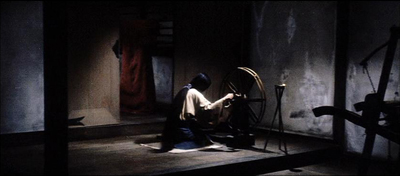
It's the story of a callous samurai who leaves his wife for the daughter of an aristocrat who can give him more money and a better social position. Of course, dating an aristocrat means putting up with ohaguro and hikimaru, neither of which was exactly fashion's finest hour:

Not too surprisingly, the samurai starts pining for his old, non-aristocrat wife, with white teeth and normal eyebrows. But a word to the wise: if you've done someone wrong and decide to make amends, and when you return to your old home, you find her just as you left her, apparently glad to see you—despite the weeds that have grown up through the floor and the caved-in roof—you should probably not sleep with her, no matter how nostalgic you both feel. You're setting yourself up for the worst coyote morning ever.
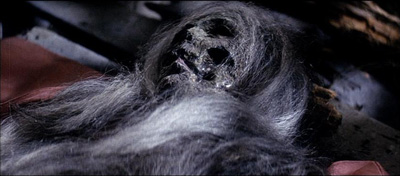
That's a pretty traditional ghost story, but it's made creepier by a wildly non-traditional score by Tôru Takemitsu. The climactic scene plays with hardly any music, only the sounds of boards and bundles of sticks being snapped in half. There should be diagetic noises of boards breaking; the samurai throws himself through a door and the floor caves in beneath him, but that happens silently. Playing the "things are so wrong and supernatural that the audio track has become unglued from reality" card is a risky move, but Kobayashi and Takemitsu make it work here, mostly because the soundtrack is creepy and startling in its own right. The Carol-Reed-style camera angles don't hurt, either.
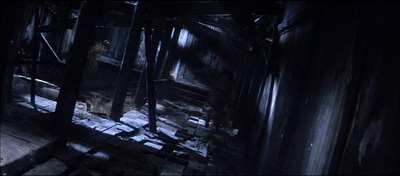
"The Black Hair" doesn't just have the Platonic ideal of a Japanese horror film title, it's also the most frightening of the four stories in the anthology. "The Woman of the Snow," the second story, has moments as creepy as "The Black Hair," but the emphasis is on unease and weirdness rather than horror, and that's the mood for the rest of the film. As with "The Black Hair," a woman is the focus of all of the terror, but "The Woman of the Snow" is more or less the film's moral inverse; in "The Black Hair," Michiyo Aratama is playing a basically good woman who is sinned against. In "The Woman of the Snow," Keiko Kishi plays... something else.
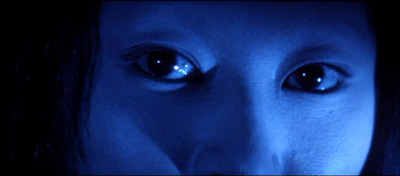
She's a yuki-onna, an ice ghost, who freezes men to death and bleeds them dry. The sexual politics are left as an exercise for the reader, but the cinematic ways Kobayashi makes her eerie and inhuman are worth studying. The main trick is lighting:

You can see how carefully the light on her white kimono is aimed to keep her face icy blue. Also note the strange way Kishi is carrying herself; there's a shot later that uses Cocteau's technique of putting an actor on a dolly so they seem to glide along without walking. I originally believed that was being done in this sequence, but it isn't; Keiko Kishi just walks that way. This is also the most expressionistic of the stories, with completely unreal outdoor sets that heighten the sense of weirdness. For no apparent reason, there are eyes in the sky:

That kind of painterly, surrealistic set is more associated with theater than film (probably because it's built around a backdrop), and I have to confess, I love it. That's winter: eyes staring balefully at you from the sky (that's why I moved to Los Angeles). But summer doesn't look much more inviting:
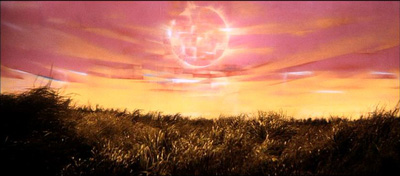
Expressionism serves the second story well, but it doesn't rise to the same level of horror as "The Black Hair," simply because it doesn't have the same queasy undertones of guilt and repression. The protagonist is more or less blameless: a good-looking innocent who grows up to be a loving father and husband. If "The Woman of the Snow" has a message, it's that there are considerably stranger things going on beneath the surface of most other people than you might imagine. Which is true, but a lot more comfortable to think about than regret and betrayal.
The third story, "Hoichi the Earless," despite having the most arresting visual image, is probably the least frightening, unless you're terrified by biwa music. It opens with a recreation of the battle of Dan-no-ura that looks like a producer's nightmare.

I would have loved to be at the meeting between Kobayashi and the Toho execs where he explained that he needed to stage a 12th century naval battle, with period ships and costumes, and he needed to do it indoors. I suppose this was always seen as a prestige project, rather than the kind of exploitation we associate with horror films in the states, but still, this must have been expensive.
Which is not to say that Kobayashi didn't do it as cheaply as possible; many of the tricks in Roger Corman's playbook are on display here. You'll notice lots of medium shots and no wide shots, which means the same extras can be used more than once. In place of wide shots, Kobayashi uses the educational film trick of panning over a historical painting of the battle, which is surprisingly effective, since part of the point of the sequence is that it happened a very long time ago. I wouldn't recommend this technique if you're trying to shoot a space battle, however.
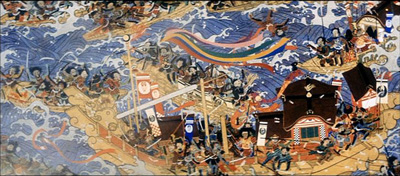
You can see that the skies are not as expressionistic as the ones in "The Woman of the Snow," but rest assured, the shots of the Emperor's attendants throwing themselves into the blood-stained sea are just as striking.
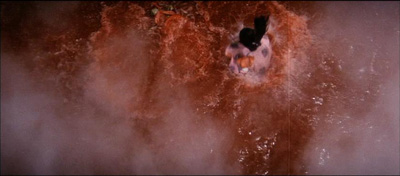
The Battle of Dan-no-ura is just prologue, however, and I must regretfully inform readers that the main story of "Hoichi the Earless" involves a great deal of biwa music. This is certainly apt: the story is about a blind biwa player who becomes renowned for his version of "The Tale of the Heike," an epic poem that was traditionally sung. Word of his version reaches the underworld, and the principles of the original battle arrange a command performance (they probably think the song is about them). So, yeah, there's diagetic and non-diagetic biwa a-plenty in this chapter, and I just don't have an ear for traditional Japanese music. The visuals nearly make up for it, however, especially at the end. Hoichi can only escape the ghosts who want him to perform for them by having prayers written on his body.
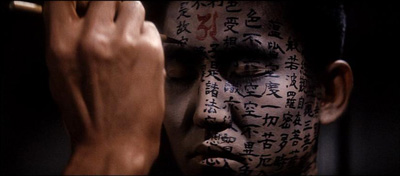
There's a semiotics thesis just waiting to be written there, if it hasn't been already.
The final story, "In A Cup of Tea," was a very odd choice for inclusion in the film. The Lafcadio Hearn version is kind of a trick story about narrative expectations, and not exactly screaming out for a film adaptaton. Hearn presents a story that—he informs us before he begins—was left unfinished. Despite the warning, anyone reading will get caught up in the story-within-the-story, about a samurai who starts seeing a ghostly reflection whenever he sees water.

All the elements of a great ghost story are there except the ending, which Hearn chides the reader Nabokov-style for expecting:
I am able to imagine several possible endings, but none of them would satisfy an Occidental imagination.
It's a nice little bit of metafiction, and it works pretty well on film, but Kobayashi, maybe sensing that this finale would be something of a letdown for an audience that had been watching Kwaidan for the previous three hours, makes a critical change to Hearn's structure that I don't think works. He doesn't do the worst thing: he doesn't resolve the story-within-a-story any more than Hearn does. But he does attempt to link that story and its framing device, in a way that plays like a traditional ending. I can understand the impulse, but if he wanted to have a satisfying narrative conclusion to his anthology (the sort of conclusion that Hearn derides as being typical of the "Occidental imagination"), then maybe "In A Cup of Tea" wasn't the best story to end with. It seems perverse to tack a sort of metafictional resolution onto a story that is very deliberately about (and against) the desire for narrative resolution. Of course, if you haven't read the story, all you'll notice is an ending that's a little too clever for its own good.
So how does the whole thing play, in all it's sprawling glory? Not badly at all, although the stories seem to be arranged in order of diminishing emotional affect. Anthology films can be hard to judge in their entirety: does the creepiness of "The Black Hair," or "The Woman of the Snow" make up for the slow pace of "Hoichi the Earless?" Clearly, "In a Cup of Tea" is an attempt to tie the whole enterprise together by making the movie about storytelling itself. That's all to the good, except that "In a Cup of Tea" doesn't quite have the courage of its own convictions. We're left with two excellent ghost stories, one average one, and one that doesn't quite work. Two out of four ain't bad.
Randoms:
- Lafcadio Hearn led an almost comically adventurous life. Born in Greece to Irish parents, he was raised in Dublin, became a reporter in Cincinatti, Ohio, scandalously married a black woman, lived in New Orleans for ten years, where he was one of the early recorders of Creole cuisine, lived in the West Indies on assignment for two years, moved from there to Japan, changed his name, married a Japanese woman, became a citizen, and collected Japanese folklore for Western audiences for the first time. He has more than a little to do with Asian culture's exoticism in the West, but my main reaction to his biography is envy. If he'd lived till the 1960s, he would probably have become an astronaut.
- A 1907 edition of Kwaidan is available on Google Books. It begins with an introduction from an earlier edition explaining the importance of Hearn's work in light of the Russo-Japanese war and ends with a truly insane essay about Herbert Spencer and the possibility of a human society modeled on ant colonies, wherein "a more highly evolved humanity would cheerfully sacrifice a large proportion of its sex-life for the common weal, particularly in view of certain advantages to be gained." So we can give Hearn credit for not only Kwaidan, but also Equilibrium.


12 comments:
Finally, another review! I was really looking forward to this one because I really loved the first two stories in Kwaidan, and was interested in your write-up of it. Just wait until you get to Kenji Mizoguchi's Ugetsu-- it has many similar elements to Kwaidan, only I think it's much more poignant and well done (and is much creepier in parts).
I think this may be the only horror movie that's actually ever caused me to have nightmares. MAN, the final scenes of "Black Hair" and "Cup Of Tea"...those were reeeeal scary.
A few thoughts to contribute:
--The Takemitsu score truly is brilliant and I would argue one of the finest genre scores ever.
--John Milius says made a great impression on himself, George Lucas and Francis Ford Coppola: he pays homage to it in "Conan The Barbarian" in several scenes, most clearly when Conan has the spells painted all over him.
--When I met Paul Schrader recently I did NOT get a chance to ask him if "Kwaidan" was as major an influence on "Mishima" as I have always suspected. However, when I met William Friedkin a few weeks later he did confirm that "Kwaidan" was a big influence on "The Exorcist". He claimed he had at one point actually tried to approach Takemitsu to do the score for "Exorcist" but could'nt reach him in Japan.
Thank you for your comment in my blog.
I love your blog and e come here every week to see if there are new posts.
Keep up the extraordinary good work. :)
Sara,
Looking forward to Ugetsu!
JJ,
A Takemitsu score for The Exorcist would have been amazing. It's so weird to think of these movies, now 40 years old, as having been as electrifying and inspiring as they clearly were to people who saw them earlier. I can't think of a movie that I've seen recently that broke new ground the way something like Kwaidan must have (the score, especially). I feel like a lot more of the territory of filmmaking has been mapped by now, you know?
Hi, Matthew, I love your blog! All your posts are superb. Please accept the Splash award, and thanks.
http://gatochy.blogspot.com/2009/04/splash-award.html
Kwaidan is an odd one for Kobayashi, who tends to pack his movies with social and political commentary (Or rather, criticism. He spent his life subverting the Samurai movie). Kwaidan is a bit like if Oliver Stone decided to direct a horror movie.
Good commentary, but I must say, I actually found "The Black Hair" to be easily the worst of the segments. I found it appropriately scary, but too much of what could be called a "punchline" plot, where the entire point is contained in the last scene. Roughly half of the segment is ineptly done and rushed exposition. It rather weakened it for me, even if the "punchline" itself was excellent.
"Woman of the Snow" I found to be the best. Part of that I have to credit to the acting (Including that of the "good looking innocent", played by Tatsuya Nakadai One of Japan's finest actors. You'll be seeing him again and again, especially with Kobayashi), which is, well, relatively existant in this segment. Mainly it's because the effort of the filming was spread around multiple scenes, meaing the "punchline" (hard to avoid in a ghost story, I admit) was less pronounced.
Beyond that, I agree with you on the other two.
Hi Matthew,
nice blog you have.. very detailed posts examining the movies.. as an amateur film enthusiast, its a very interesting read for me to know abt the trivia concerning this movie..
watched kwaidan just a few days back.. i too liked black hair segment the best.. the time of the segment and the building up horror was good.. women in the snow, was a bit long, but i liked the fact that the horror in that was more situational than visual.. hoichi the earless was more of a long folk tale, not much horrifying.. at times the biwa music was irritating .. i kinda liked the final segment.. short and eerie.. with good amounts of visual scare, but Hearn's story seems to be much better and open ended.. which actually is the essence of his story, but difficult to translate to a movie, without boring the audience.. but that segment was good if you forget its original story roots..
Excellent and perceptive review, as always. I think the uncanny effect Toru Takemtsu's sound design lends the film can't be understated. The one observation you made that struck me is how the sound of the samurai crashing through the floorboards in "The Black Hair" is offset from the action. Although I thought the sudden switch from diagetic sound to Takemitsu's sound sculptures during the climax was brilliantly disorienting, it somehow hadn't occurred to me that the clattering percussive noises surrounding the fall were actually the displaced sounds of the floorboards breaking. I've credited that idea to you in my own review.
366weirdmovies,
Thanks for the link! Yeah, the sound in "The Black Hair" is brilliant.
Matthew, regarding your comment in the "Hoichi the Earless" segment "I wouldn't recommend this technique if you're trying to shoot a space battle": The Hideaki Anno (of EVANGELION fame) anime GUNBUSTER used panning shots across painterly compositions of star battles in mid-fight, with intertitles listing the casualties and other details of the battle, to accomplish the same effect you see here. It implies huge action and great loss without costing a lot, so Anno can concentrate on scenes with Noriko's Gunbuster mech.
It was nice to read this post and a few of your others. I have read similar titles but the authors were too biased.
Thanks.x90p workout
Just found your blog, fine stuff, and though I dig much of your take on Kwaidan, I'm compelled to quibble with your view of the ending. A part of me really loves how the unfinished story is sort of answered by the unfinished frame story, in a way that - and this just might be my Yiddish roots talking or something - seems to imply that the answer to the question is that the question gets worse.
Also, man, does it ever go for broke with the last shot.
Post a Comment